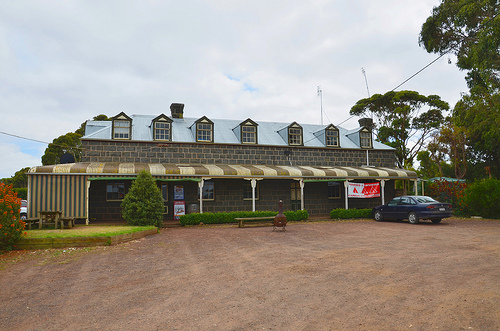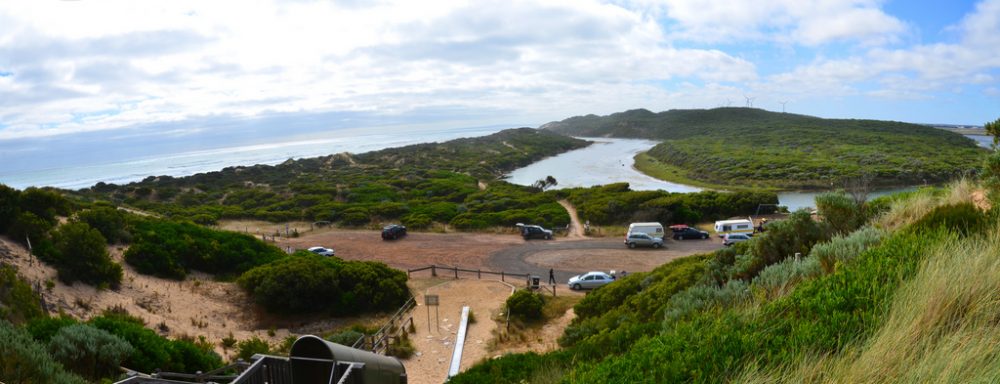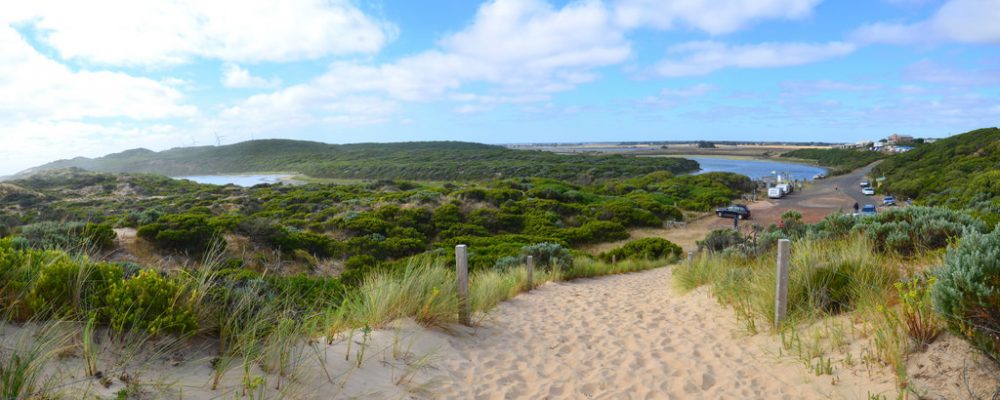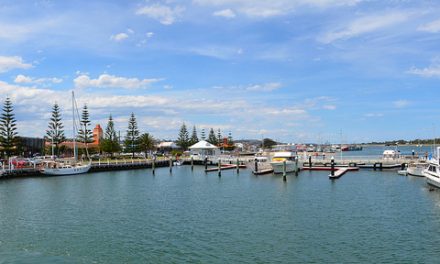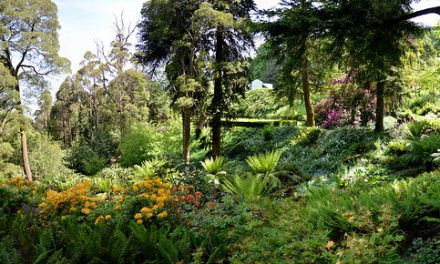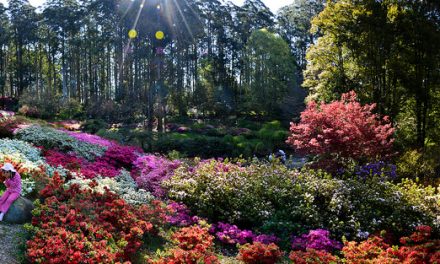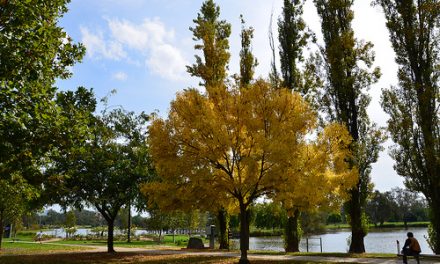Yambuk is a small town 18 km west of Port Fairy and 296 km west of Melbourne, where the Princes Highway crosses the Shaw River. At the 2006 census, the town and surrounding area had a population of 540.
“Yambuk” has been variously interpreted as referring to the red kangaroo, full moon, eel lake, big water and so on. Whatever the meaning, there is no doubt that Yambuk was originally the home of aboriginal people who enjoyed the abundant food in the area. The limestone cliffs to the east of the town have yielded numerous middens which indicate that aboriginal settlement in the area dates back at least 2300 years.
European pioneers began settling in Yambuk in the 1840s. Amongst them was Annie Baxter Dawbin who described in journals her fascinating life in Yambuk as a pioneering woman. The site of her homestead, the Yambuk Station, is now occupied by the Shaw River Buffalo Cheese Factory which makes unique cheeses and yoghurts from the milk of Australia’s only milking water-buffalo herd.
Yambuk Inn
Known formerly as the Commercial Hotel, this is the town’s most historic building and was once an important stopping place on the road between Port Fairy and Portland. Originally constructed from timber in 1856, it was replaced with bluestone in 1870-71.
The present building was designed by pioneer architect Captain John Mason and features walls of squared basalt with a dormered attic. The steeply-pitched iron roof is regarded as evocative of early building traditions in NSW and Tasmania. The bullnose verandah was added in the early 20th century.
Yambuk Lake
The lake is accessed via Yambuk Lake Road, which ends in a carpark (GPS coordinates S38.34068 E142.05258). We happened to witness sheep being herded back to their enclosure from their pastures along this road.
Yambuk Lake is actually an estuarine lagoon which receives freshwater inflows from the Shaw and Eumeralla Rivers as well as tidal seawater from Bass Strait when opened. When the estuary’s mouth is closed by a build-up of silt, the lake is flooded by freshwater until the entrance is opened mechanically.
This area is part of the Yambuk Important Bird Area (IBA), a 10 km2 tract of coastal land fronting Bass Strait which encompasses the lower reaches of the Eumeralla River and Yambuk Lake. Together with the adjacent Yambuk Nature Conservation Reserve and Deen Maar Indigenous Protected Area, the IBA is home to a wintering population of critically endangered Orange-bellied Parrots. It also supports a breeding population of Hooded Plovers and has regular records of Australasian Bitterns. The Eumeralla River is the main stronghold of the rare fish Dwarf Galaxias pusilla.
The coast is dominated by dune shrubland, featuring Coast Wattle and Coastal Beard-Heath with scattered emergent trees. Behind the dune scrub, the margins of the lake support saltmarsh, reed beds and other forms of wetland vegetation, with patches of closed swamp scrub and low open eucalypt woodland on the northern inland side. Several species of rare plants, including Coast Ballart, can be found on the river and lake edges.
Yambuk Lake and the adjoining wetlands are used for fishing, duck-hunting, boating, walking and bird watching, with over 100 species being sighted. There is a boat ramp, a small adjoining fishing wharf and a playground by the lake. The lake is not suitable for waterskiing and swimming. Before reaching the carpark, you will pass by the Yambuk Lake Caravan Park which has 40 powered sites, 2 barbecues and a basic amenities block.
Yambuk Beach is unpatrolled and have dangerous waters so while careful wading is fine, one should not venture too far out to sea. You can see Lady Julia Percy Island in the above video – this appears as an elevated line above the sea horizon. Read more on this island from this post.
Yambuk Slide
This is an iconic giant slide in the sand dunes on the eastern side of the lake opposite the boat ramp. It appears from this video on the history of the slide that the original slide was built in 1982, with the aim of safeguarding the hill from erosion and with the parts being transported from Melbourne. The original slide was higher, steeper and slid faster.
Eumeralla Garden and Rugosa Studio
Situated on 5 acres, this garden features features groves of lilacs, elms and birches with perennial borders planted with irises, lilliums and bulbs. It also has plantings of rugosa and other old-fashioned roses. There is a viewing platform over a blue, white and gold garden, a children’s garden and kitchen garden. Rugosa Studio lies amongst this beautiful setting and is the studio for internationally renowned artist Brian Dunlop.
Located in Fingerboard Rd, it is open at weekends and on public holidays from 10am to 5pm or by appointment. Entry costs $3 per person.
Codrington
This town, located 10 km west of Yambuk, is the only Australian township that is named after a bushranger. In 1850, Codrington Revingstone held up the Portland to Port Fairy mail coach three times and the area became known as “Codrington’s Forest“. In the 1870s, a township was surveyed on the projected road to Portland close to the coast and named, unwittingly, as Codrington. A road was later built inland and the proposed coastal township is never established.
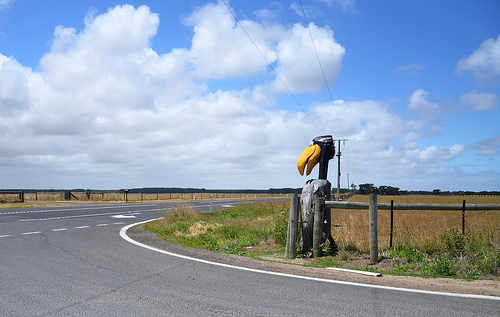
Bird statue guarding the entrance to Codrington Wind Farm
There are a few places of interest in Codrington:
- Wormwood Garden and Nursery (4887 Princes Highway) is open Wed to Sun and most public holidays, 9am-5pm. It has several display gardens, a lavender walk, a keyhole garden and “the nook by the brook“, all set around an Edwardian home (c.1900).
- Codrington Nursery is open Wed to Sun, 10am-5pm and specialises in native trees, shrubs and ground covers with an emphasis on coastal plants and indigenous species.
- Codrington Wind Farm has been running popular mini-bus tours (generally Thur-Sun, 10am-4pm) since it opened in 2001. Besides informative commentary on the wind farm’s development and operation, visitors are treated to magnificent views and close encounters with wandering sheep and cattle. A kiosk in the car park provides information and sells windsocks, souvenirs, excellent coffee and snacks. For those not wanting a tour, information boards and a viewing platform are available.

